Highlights and access methods of Fushimi Inari Taisha (Kyoto Prefecture)
English | Japanese
Fushimi Inari Taisha is a shrine located in the Fushimi Ward of Kyoto City. It is fondly known as 'Oinari-san' and is the head shrine of the approximately 30,000 Inari shrines nationwide. The shrine is famous for its roughly 10,000 vermilion torii gates, donated as a sign of gratitude for wishes granted, which line the pathways of Mount Inari. Particularly famous is the Senbon Torii, a dense row of gates, which consistently ranks high among places foreigners wish to visit in Japan. Historically worshipped as the deity of agriculture and rice, it is now also revered for business prosperity, industrial development, family safety, traffic safety, and success in the performing arts.
In this article, we will explain the attractions of Fushimi Inari Taisha in Kyoto Prefecture and how to access it for those who are traveling to Japan from overseas.

(Last modified: )
(Prefecture : Kyoto , Category : Shrines)
Table of contents
- Highlights of Fushimi Inari Taisha
- Visiting hours for Fushimi Inari Taisha
- Romon
- Gehaiden
- Naihaiden
- Honden
- Senbon Torii
- Okusha Hohaisho
- Omokaru-Ishi
- Kumatakasha&Shin-Ike
- Yotsutsuji Observation Deck
- Mountaintop(Ichinomine)
- Stone Fox Statues at Fushimi Inari Taisha
- Autumn leaves at Fushimi Inari Taishas
- List of photos related to Fushimi Inari Taisha
- Address and access method of Fushimi Inari Taisha
- Attractions near Fushimi Inari Taisha
- Other information about Fushimi Inari Taisha
Highlights of Fushimi Inari Taisha
We will introduce the highlights of Fushimi Inari Taisha.
Visiting hours for Fushimi Inari Taisha
At Fushimi Inari Taisha, you can visit at any time, 24 hours a day. However, please note that the shrine's parking lot is closed from 10:00 PM to 5:00 AM the following morning. There is no admission fee.
The offering hall is open daily from 8:30 AM to 4:30 PM. Additionally, the reception for prayers is available every day from 8:30 AM to 4:30 PM.
Romon
As you proceed along the main approach from the first torii gate, you will find the Roumon beyond the second torii gate. A Roumon is a two-story gate without a roof on the lower level, and the Roumon at Fushimi Inari Taisha is one of the largest in Japan. It has been designated as a national important cultural property.
It is said that Toyotomi Hideyoshi had the Roumon rebuilt as a token of gratitude for the recovery of his mother, Lady Omandokoro, from illness.
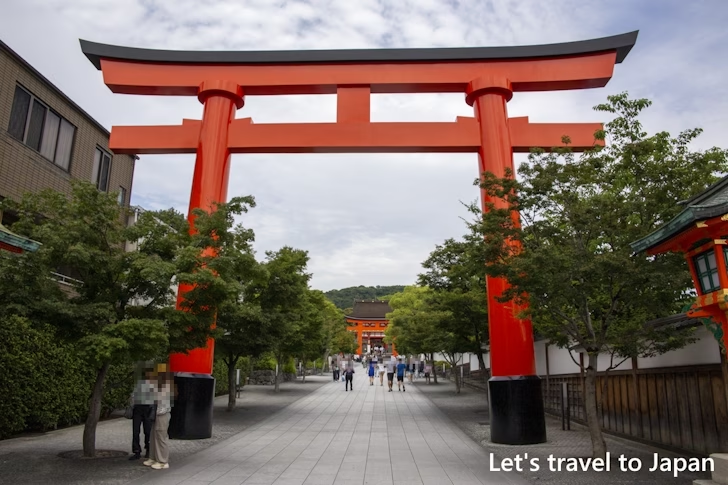
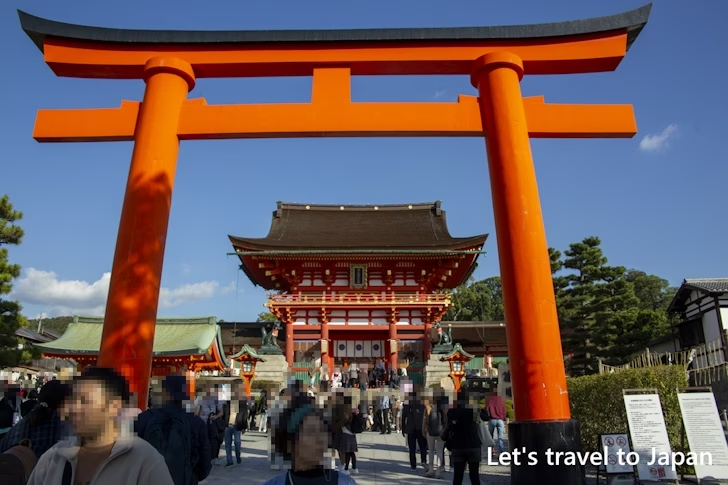
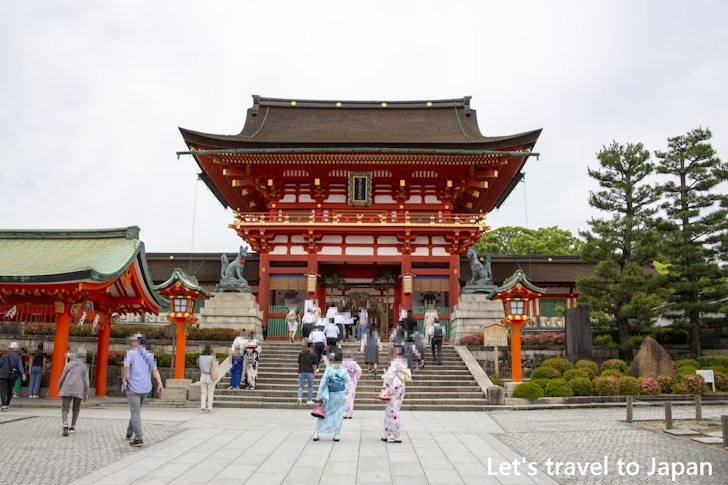
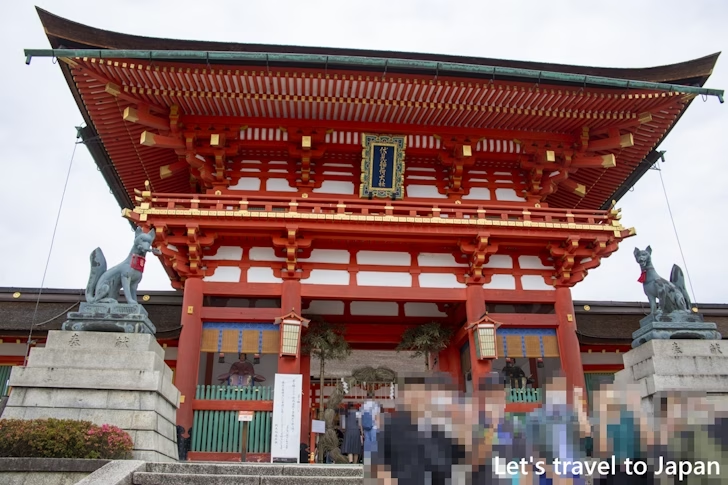
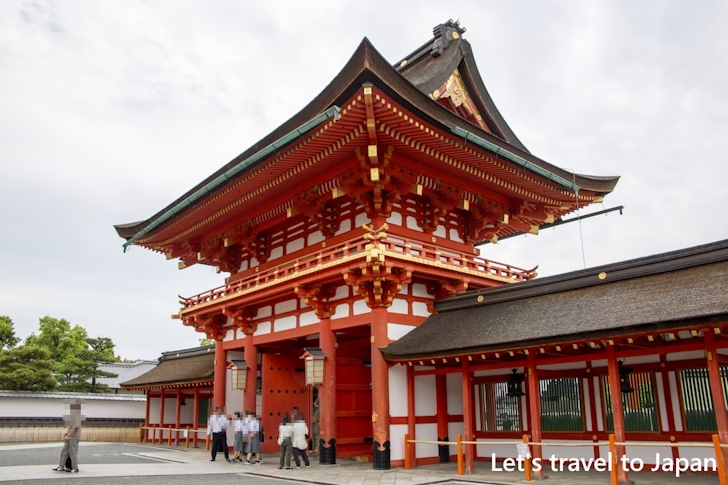
On both sides of the gate, Zuijin statues are enshrined. Zuijin were military officers who guarded the court and provided escort to nobles when they went out. The one dressed in black represents the Sadaijin, and the one in red represents the Udaijin.
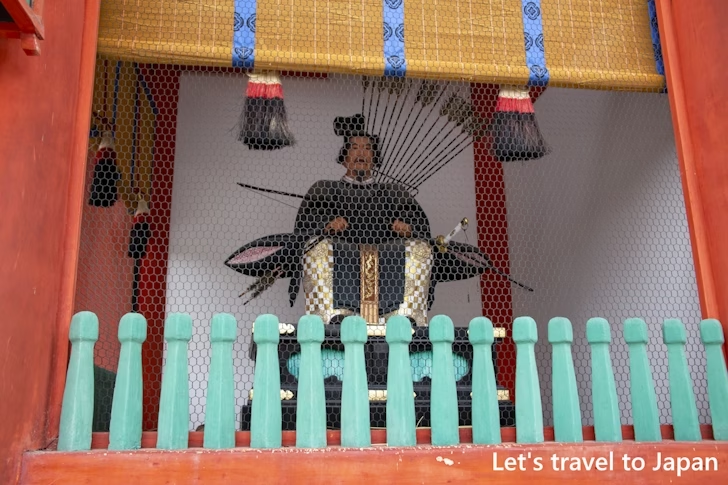
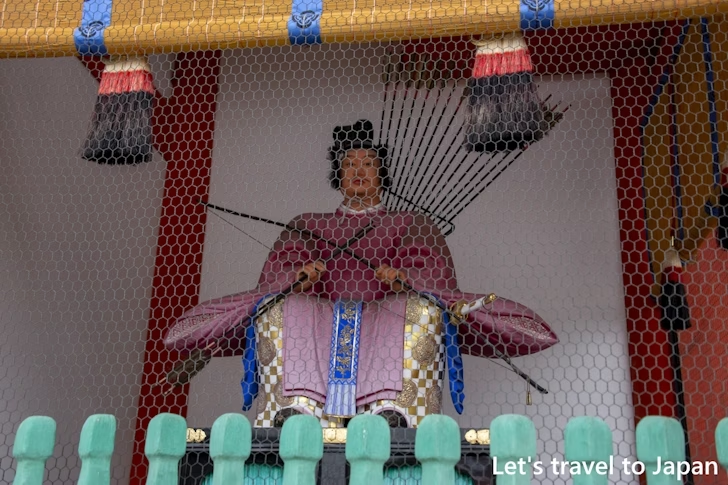
Gehaiden
Beyond the Roumon is the Gehaiden. Constructed in 1840, it was originally referred to as the Haiden. It is one of the two worship halls at Fushimi Inari Taisha, with the Naihaiden and the Honden located further ahead.
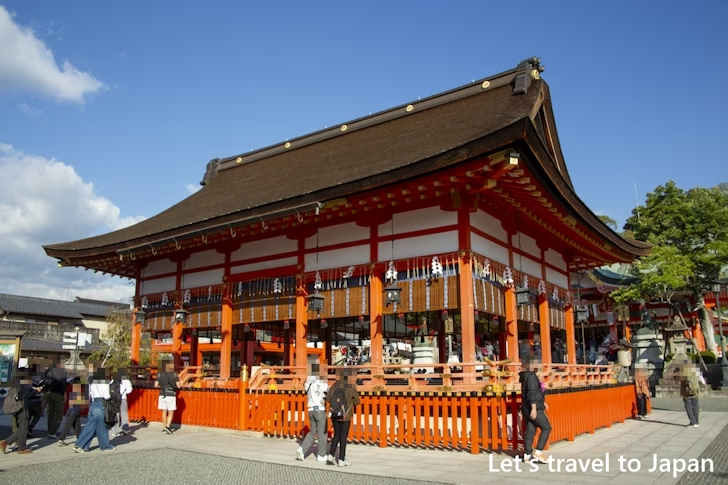
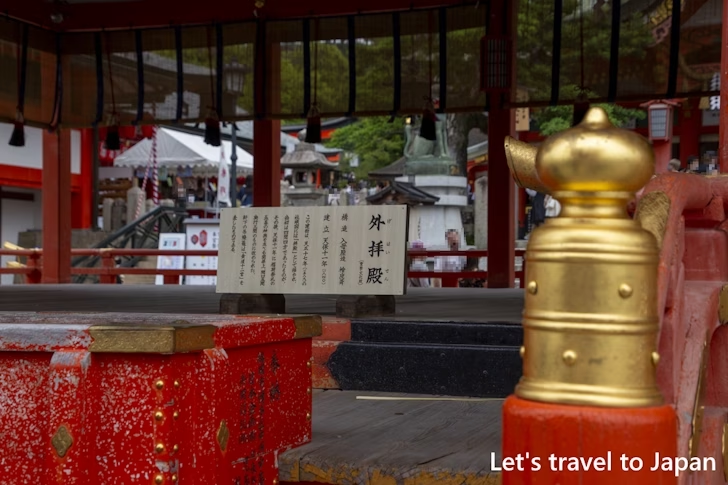
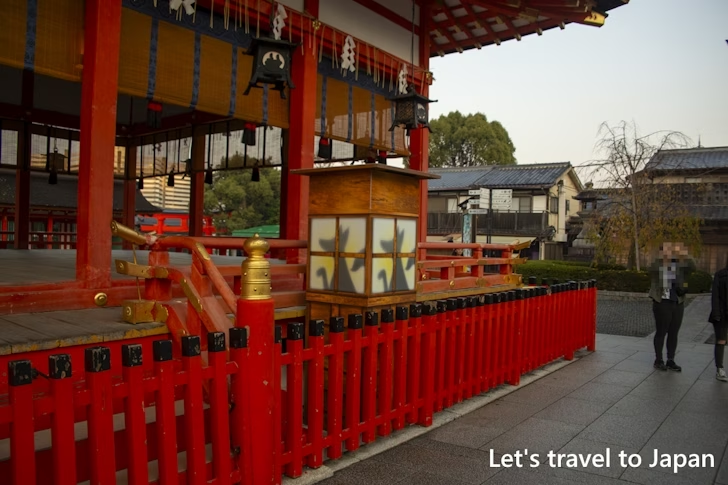
At the Gehaiden, bean-throwing rituals are held during the Setsubun Festival. During the Inari Festival, five portable shrines are lined up at the Gehaiden.
Hanging in the Gehaiden are 12 hanging lanterns. Each lantern represents one of the twelve signs of the zodiac (Kodo Junikyu) on the ecliptic. The twelve signs of the zodiac, or Kodo Junikyu, refer to the twelve constellations along the ecliptic, and each lantern is decorated with patterns representing these constellations.
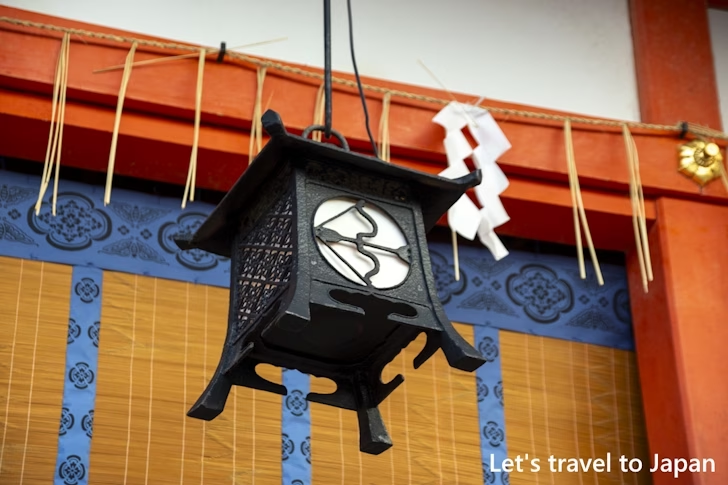
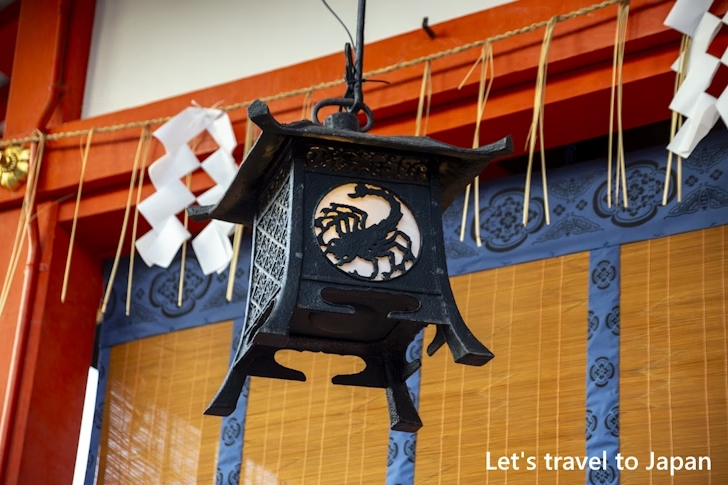
For information on all the hanging lanterns in the Gehaiden, please refer to the 「Complete guide to the hanging lanterns at Fushimi Inari Taisha Gehaiden」.
Naihaiden
Circling around the Gehaiden and going up a short flight of stairs leads to the Naihaiden. The Naihaiden features a Karahafu roof (a roof style with a convex curve in the middle). It was constructed in 1961 right in front of the main shrine. Currently, worshippers offer prayers from the Naihaiden.
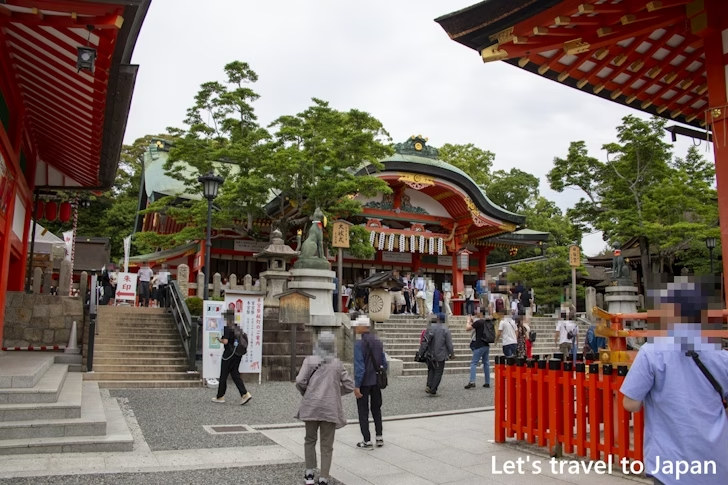
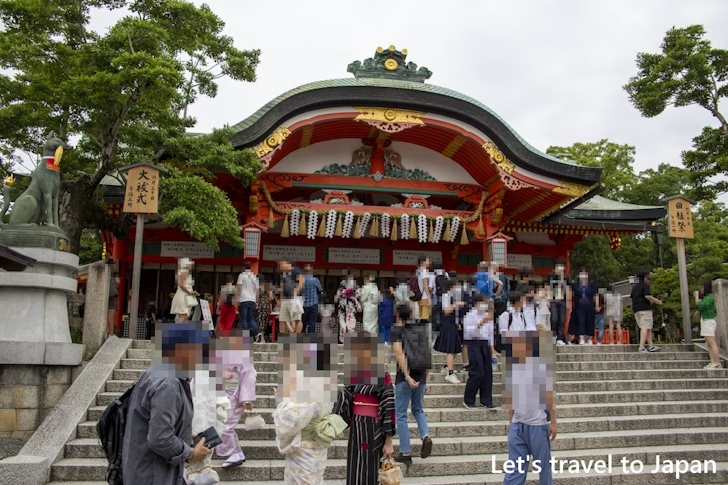
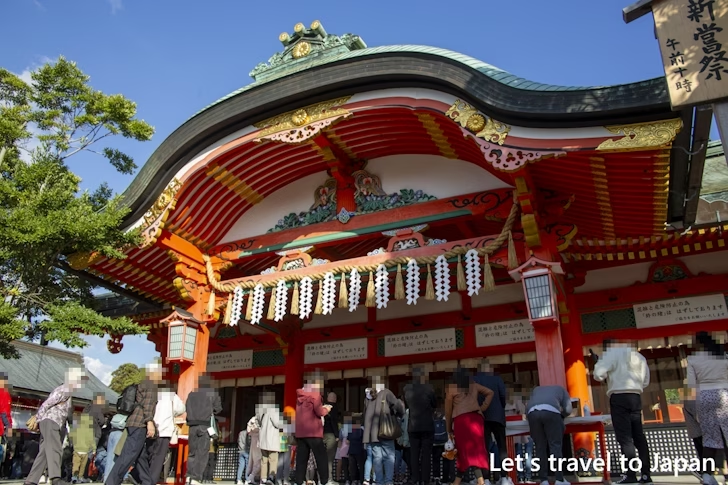
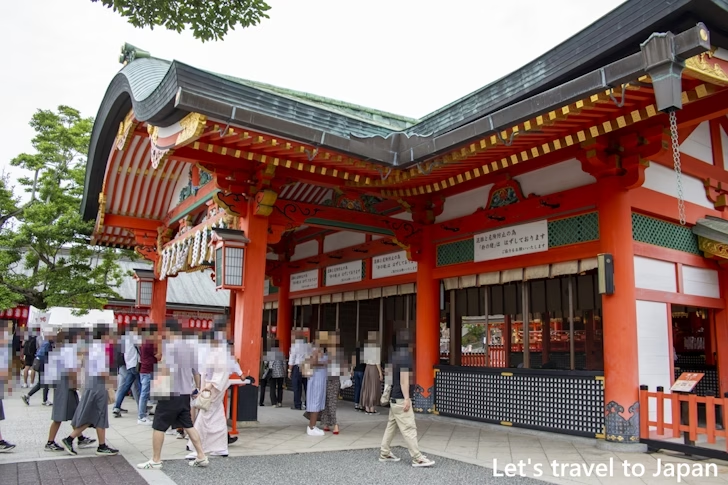
Honden
The Honden is located behind the Naihaiden. After being destroyed by fire in 1468, the current building was reconstructed in 1499 and is designated as a national important cultural property. The following photo shows the Honden from the side. The Naihaiden is in front of the Honden (to the right in the photo).
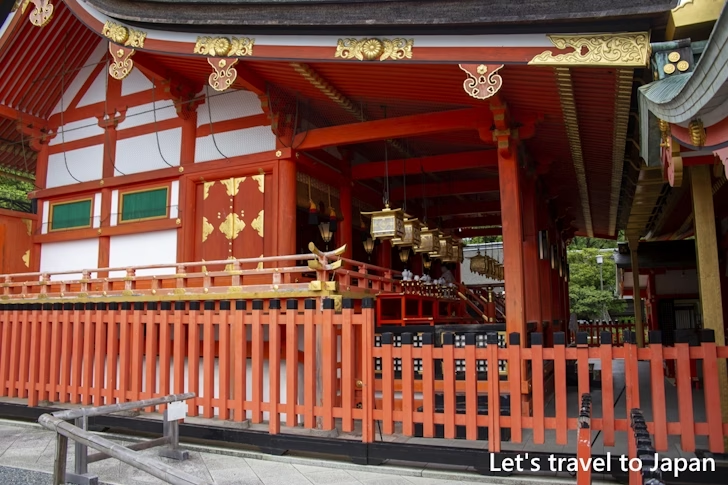
Senbon Torii
As you go up the stairs on the left side of the main shrine and proceed along the approach path, you will see torii gates lined up along the way. These gates have been donated by worshippers, and the names of the donors or their companies are inscribed on each torii gate.
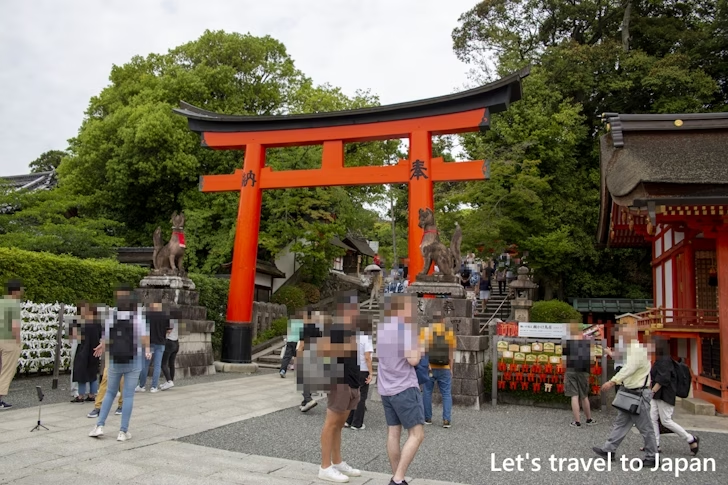
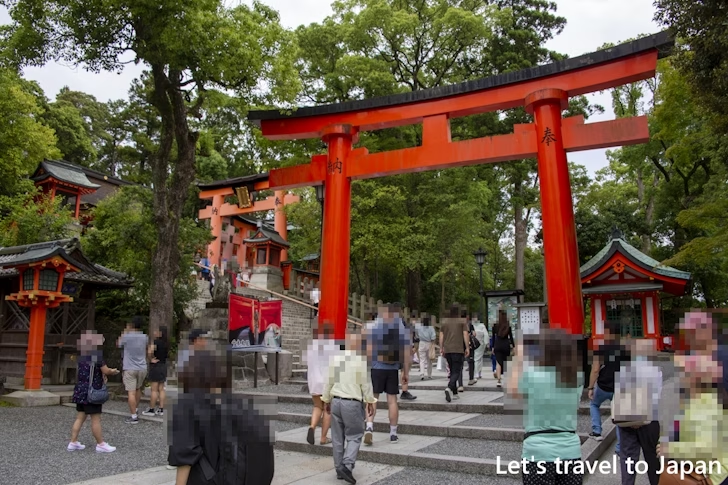
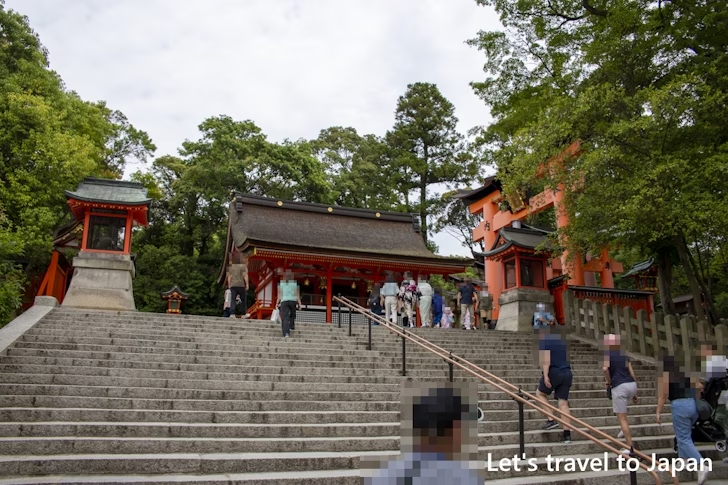
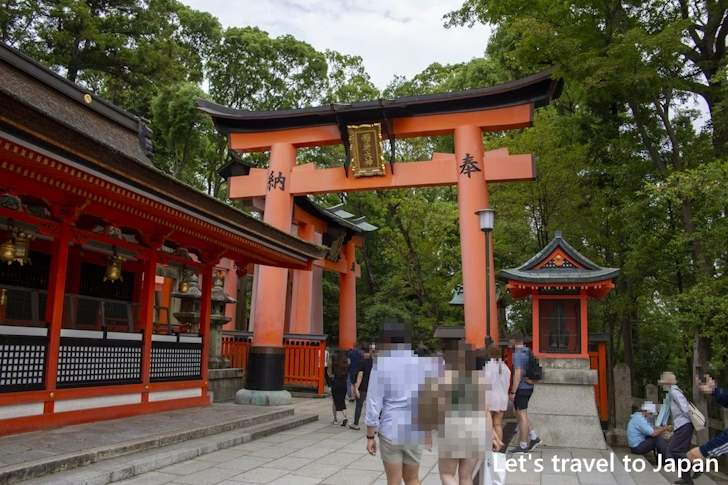
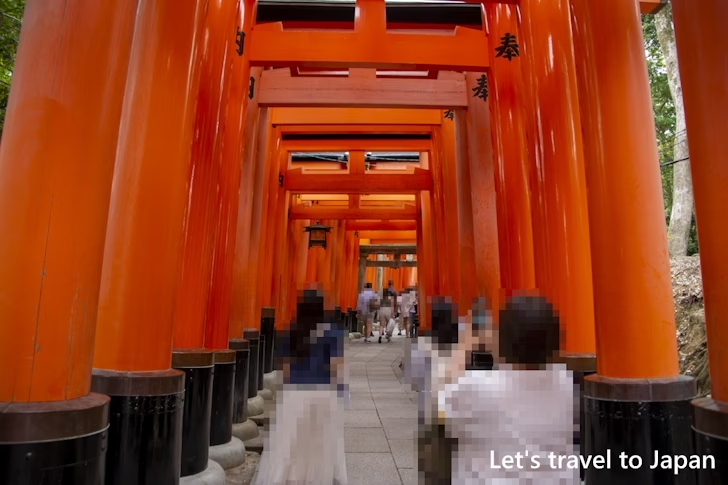
As you proceed, you will come across the Senbon Torii. At the Senbon Torii, the gates are closely lined up, creating a fantastical scene. It is said that there are about 800 gates actually built in the Senbon Torii.
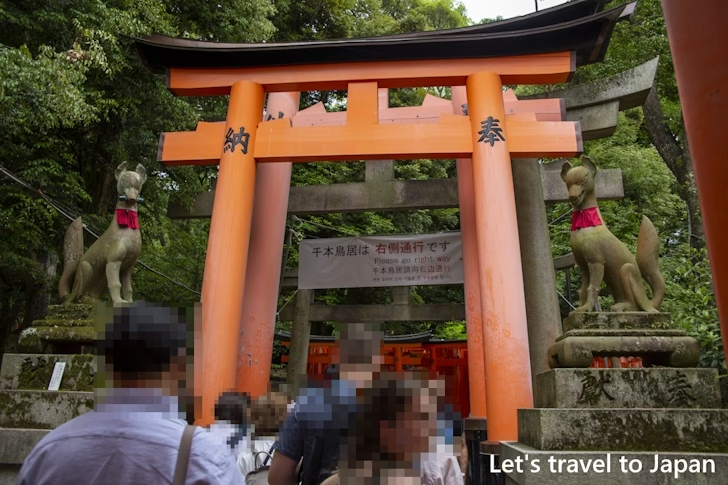
There are paths on both the right and left sides of the Senbon Torii, and you should proceed on the right side. People returning from the opposite side come through the left path. Below is a photo of the entrance from the opposite side.
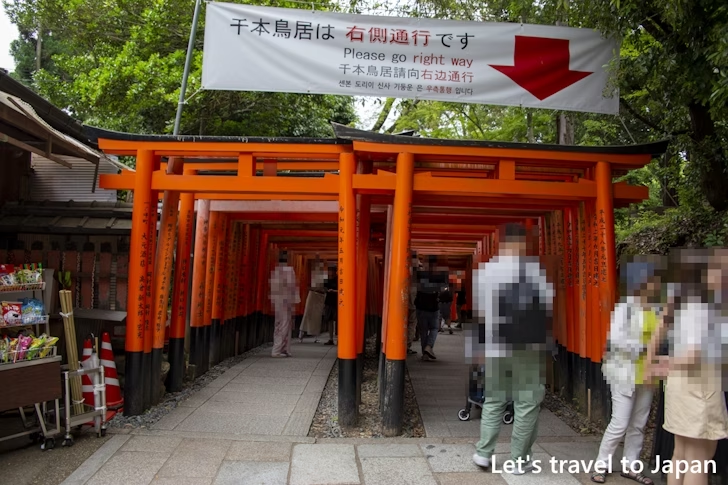
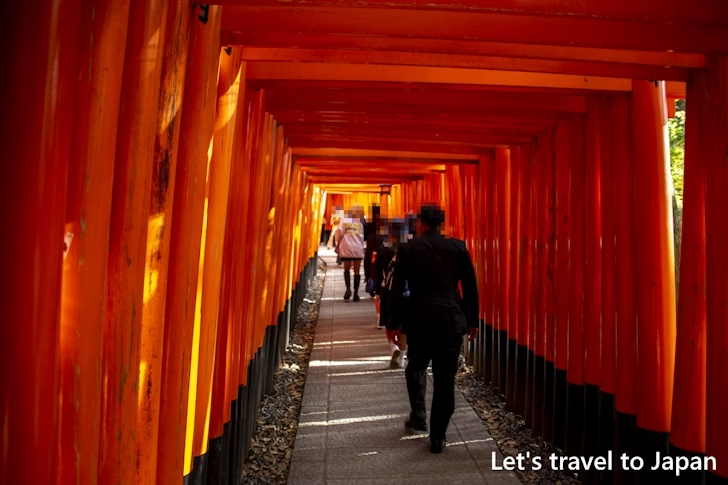
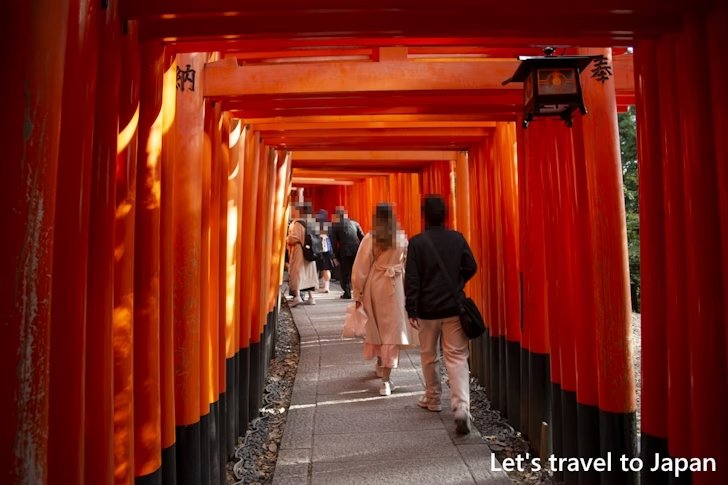
The path going through the Senbon Torii is usually very crowded as it is the main route. Many people also gather near the entrance to take photos. However, after passing through the Senbon Torii, those heading towards the mountain top often take a different route back to the Honden, so the return path through the Senbon Torii is often less crowded. If you want to take photos inside the Senbon Torii, the return path is recommended.
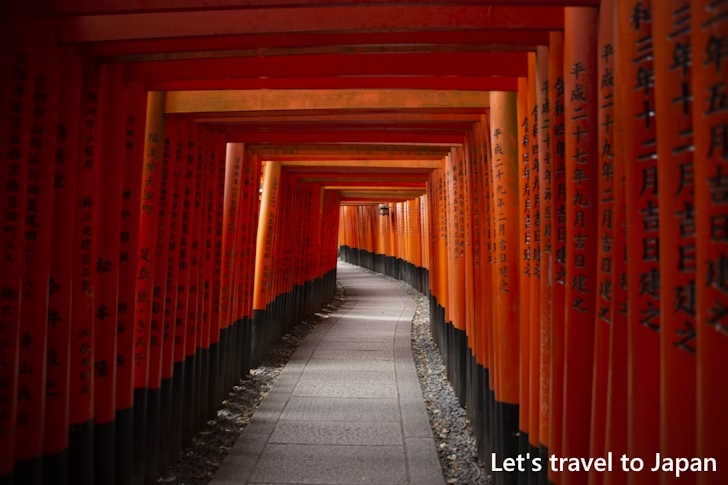
From the outside, you can see how the torii gates are built closely together without any gaps.
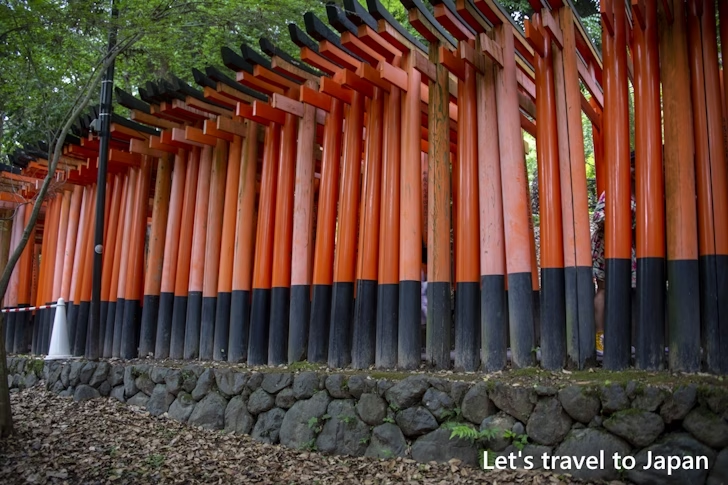
Okusha Hohaisho
Just past the Senbon Torii is the Okusha Hohaisho, also known as Okuno-in. It takes about 15 minutes to get there from the Honden. The Okusha Hohaisho is where worshippers remotely venerate the Inari Okami nshrined on Mount Inari. (Remote veneration means to worship from a distant location).
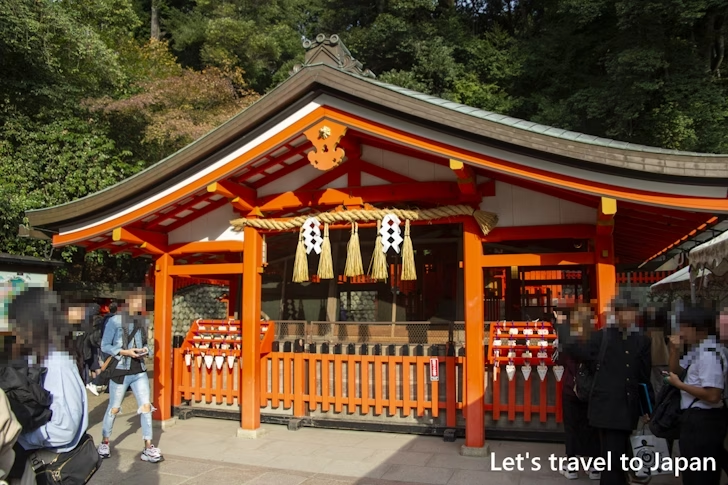
Behind the Okusha Hohaisho, there is a torii gate dedicated to the Inari Okami.
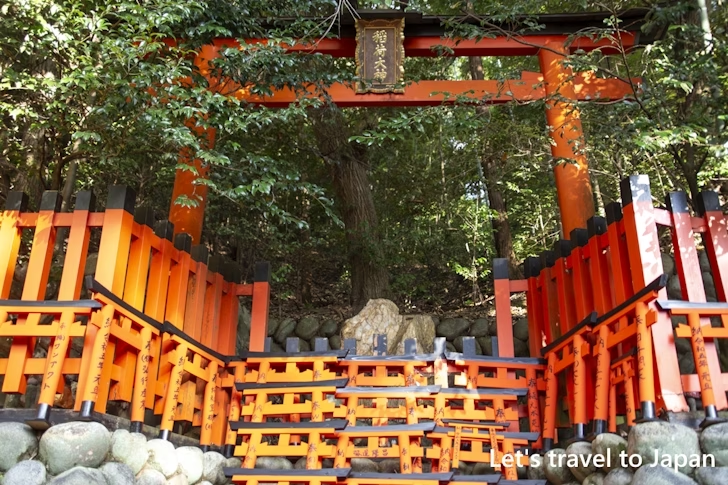
Right next to the Okusha Hohaisho, there is a tea house selling drinks and other refreshments. If you continue towards the mountain top from here, there are several similar tea houses along the way.
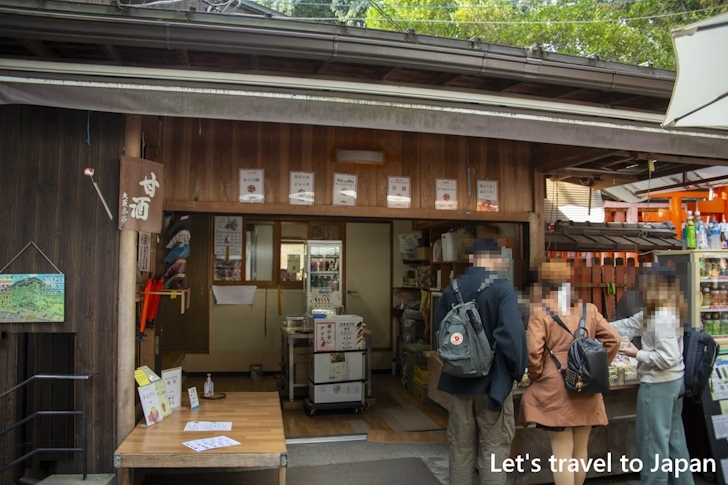
Omokaru-Ishi
To the right rear of the Okusha Hohaisho, there is a stone lantern known as "Omokaru Ishi". Try lifting the top part of this stone while thinking of a wish. It is said that if the stone feels lighter than you expected, your wish will come true.
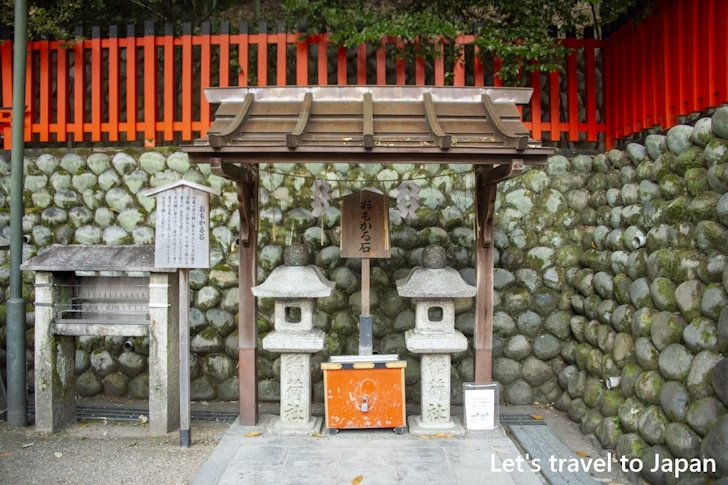
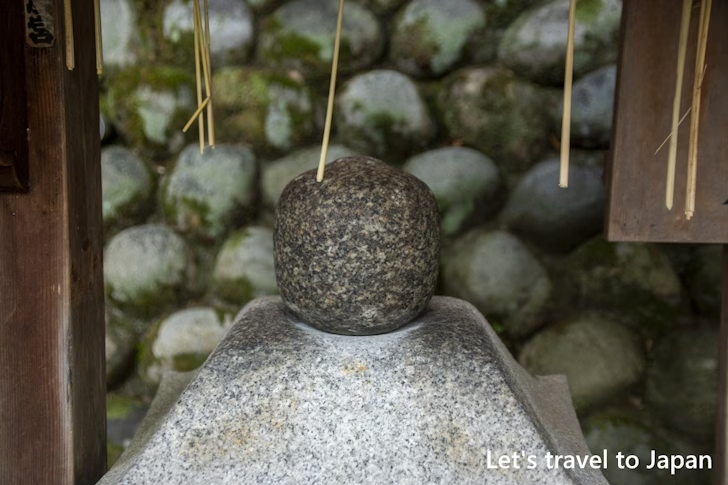
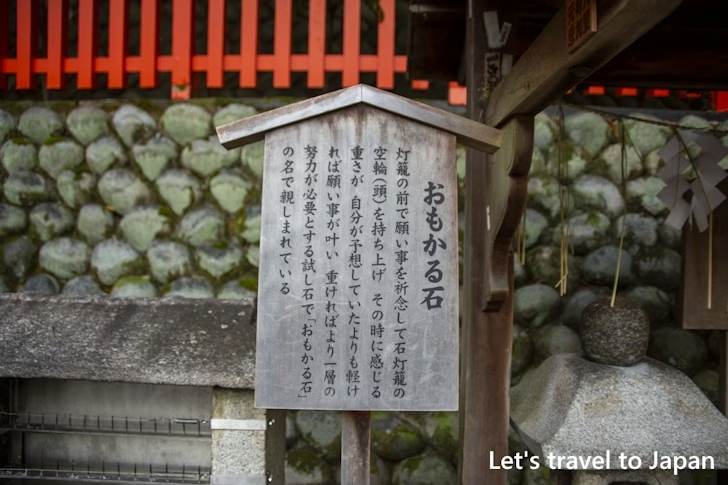
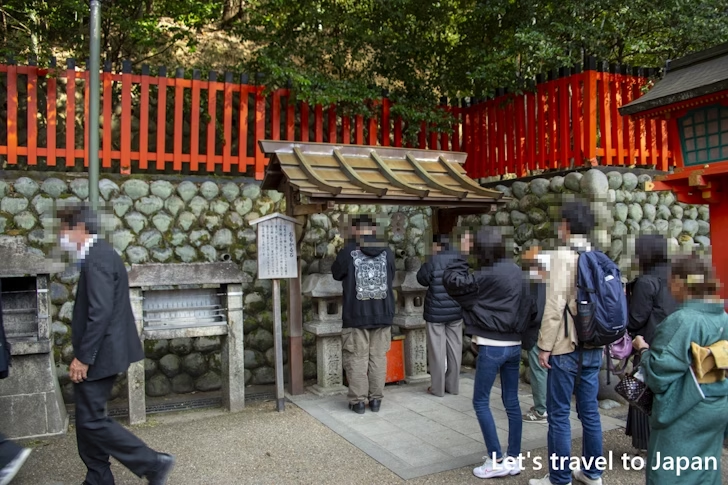
Kumatakasha&Shin-Ike
Many people return through the Senbon Torii after visiting the Okusha Hohaisho, but if you have time, you can also visit the summit. To go to the summit, proceed beyond the next torii gate.
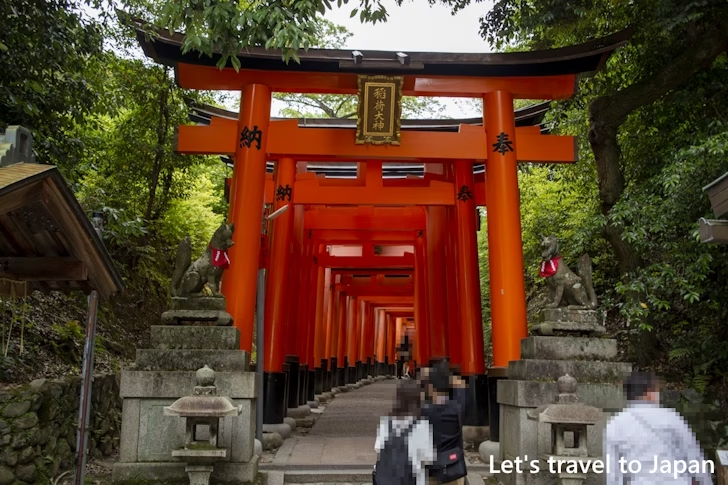
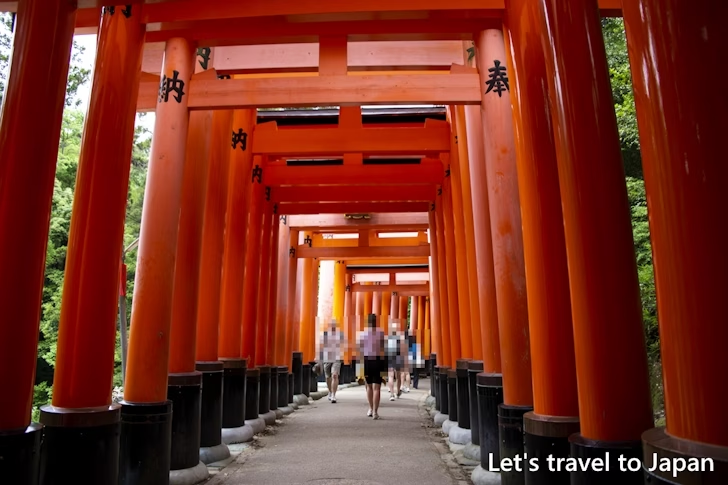
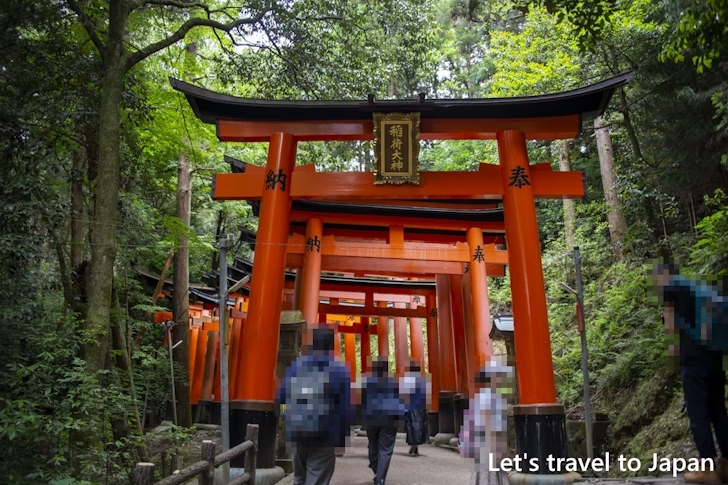
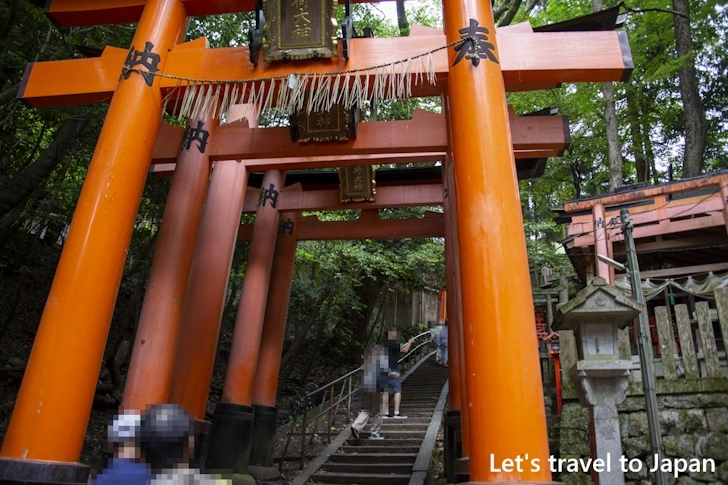
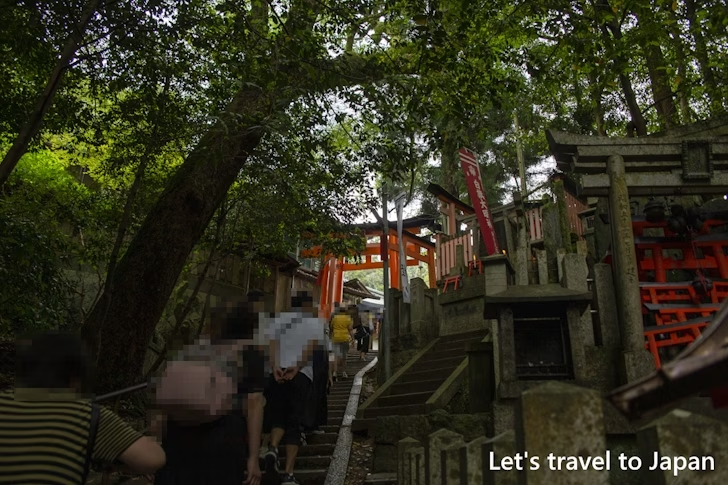
After a while, you will reach Kumataka-sha, a subsidiary shrine of Fushimi Inari Taisha. It takes about 15 minutes to walk from the Okusha Hohaisho to Kumataka-sha. If you want to make a wish or request to Kumataka Okami, buy a candle at the shop right next to the shrine, offer it, and then make your wish.
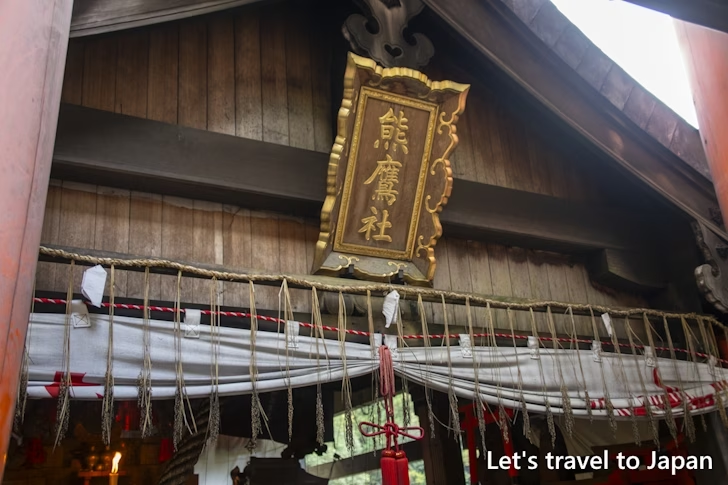
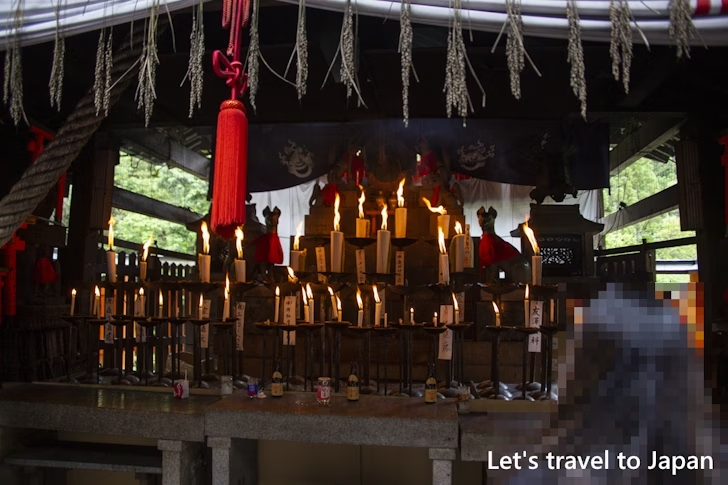
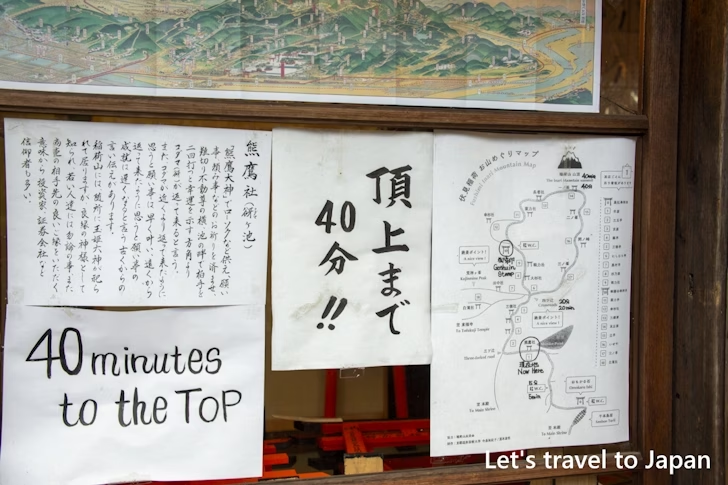
Next to Kumataka-sha, there is a Shin-ike known as Kodama-ga-ike. It is said that after making a wish at Kumataka-sha, if you clap your hands twice by the pond, an echo will return from the direction indicating good fortune. Also, if you are searching for someone, clues might be found in the direction from where the echo returns.
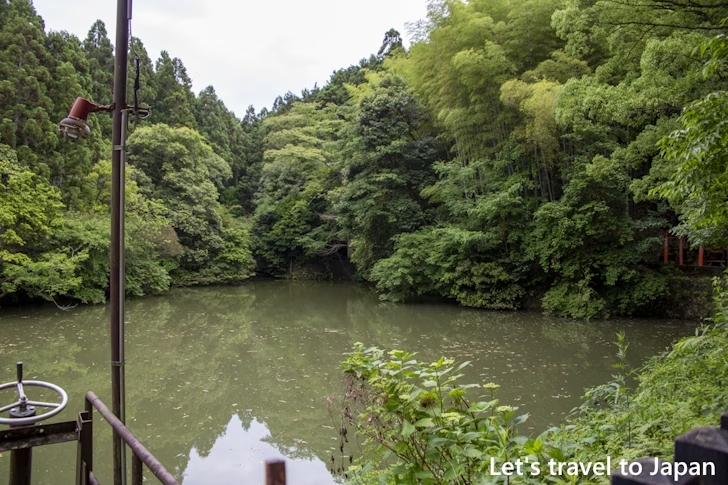
Yotsutsuji Observation Deck
After passing Kumataka-sha and proceeding further, you will reach a place called Mitsutsuji. To continue towards the summit, go right; to return to the Honden, go left.
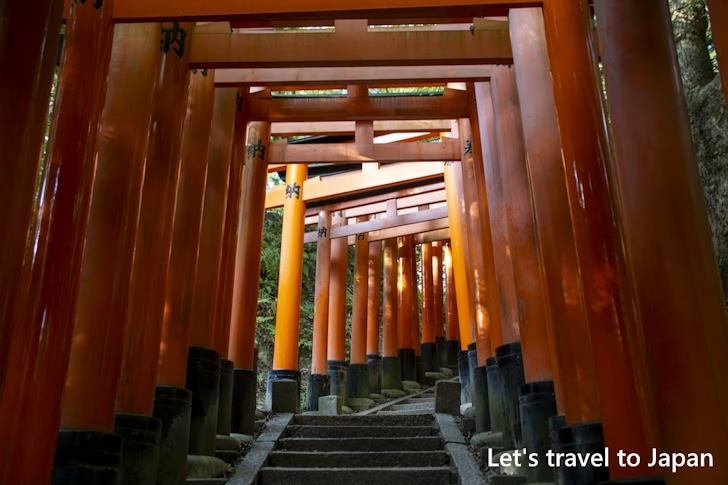
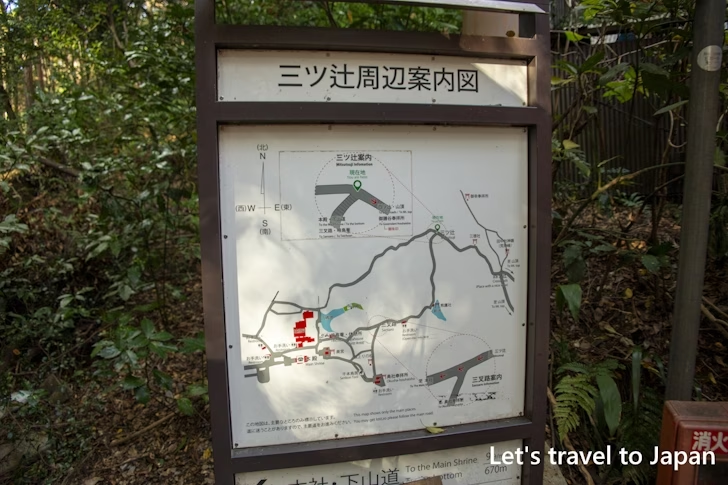
After a while, you will come to a place called Yotsutsuji. From here, there is a path that circles around to the summit.
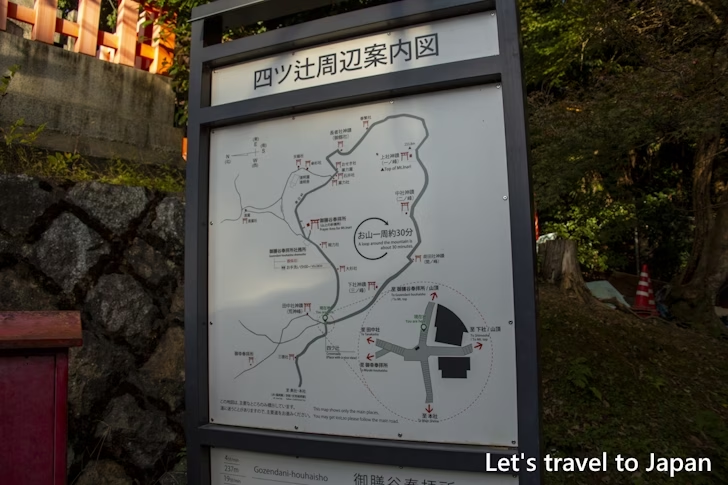
Yotsutsuji functions like an observatory, offering a panoramic view of Kyoto City. There are benches and a tea house, so please take a moment to rest before heading to the summit.
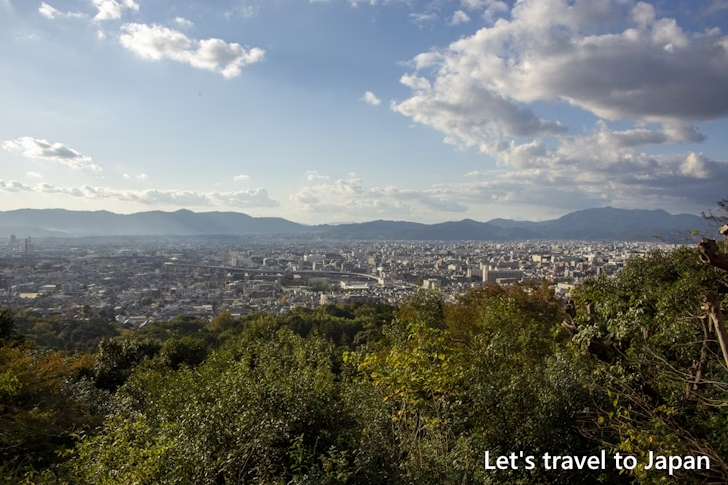
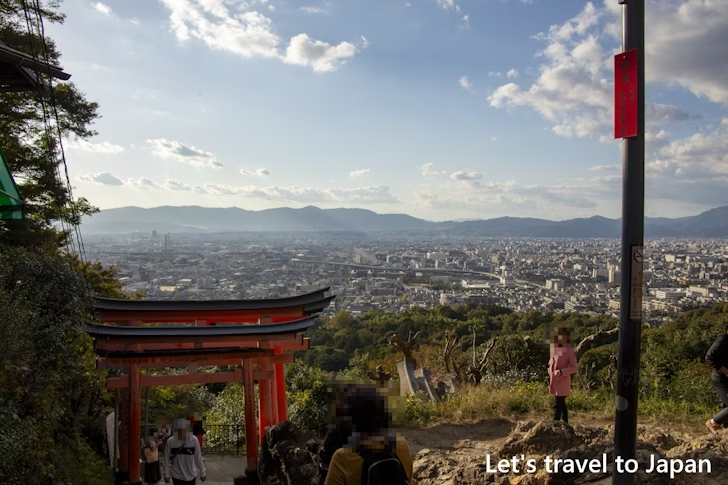
When I returned from the summit to Yotsutsuji, the sun was setting, providing a very beautiful scene.
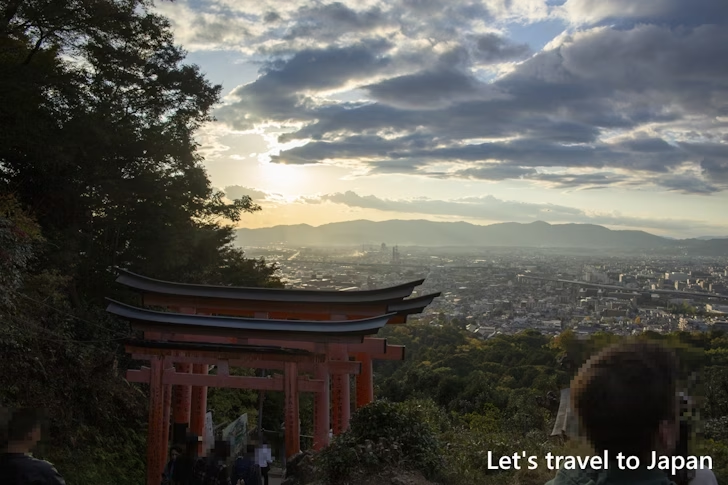
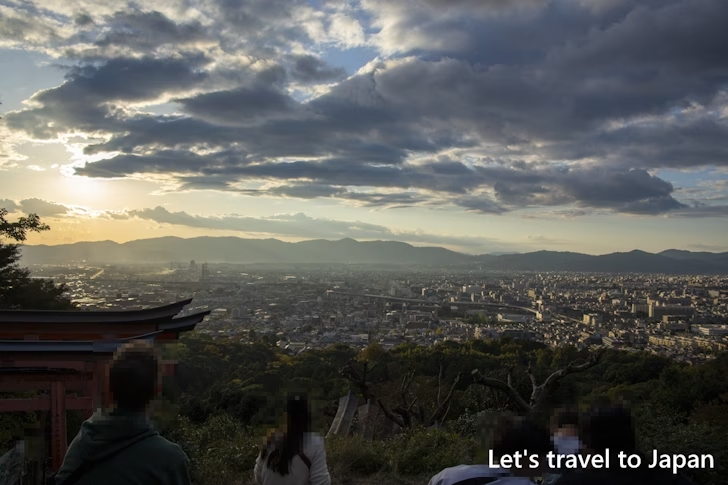
Mountaintop(Ichinomine)
There are two routes from Yotsutsuji to the summit: a clockwise and a counterclockwise course. This time, I proceeded counterclockwise and returned via the clockwise route to Yotsutsuji. Circling around and returning in this way takes about an hour. The clockwise route is shorter, so if you're short on time, you can quickly return by going to the summit and back on the same route.
At Ganrikisha along the way, there was a unique Chozuya(hand-water basin) shaped like a fox standing on its head. Ganrikisha is believed to bring benefits such as recovery from eye diseases and the granting of foresight.
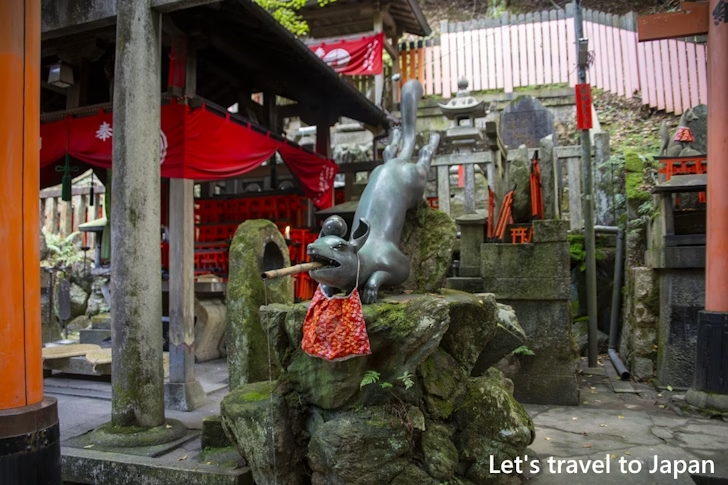
Further ahead, the path splits into two. To go to the summit, proceed to the right. If you go left, you will come to Kiyotaki. This time, I first went left towards Kiyotaki.
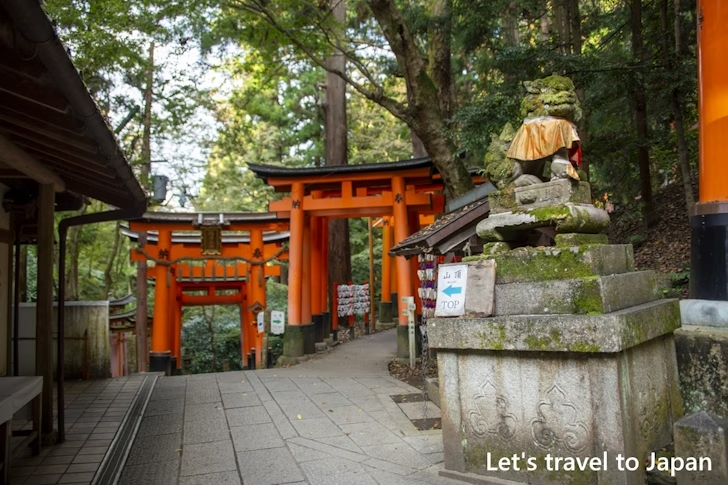
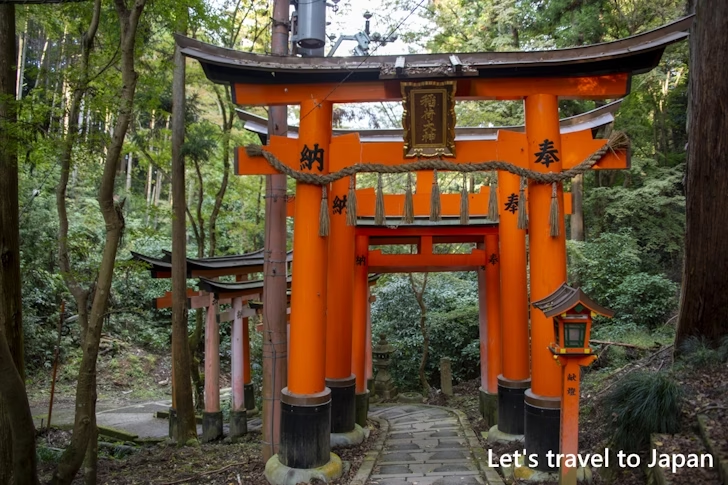
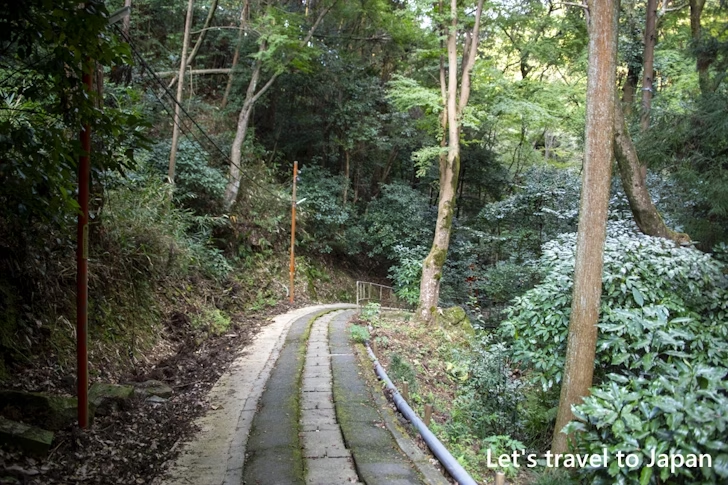
When you reach a place like the following, go left if you are heading to Kiyotaki. If you go right here, you will be on the uphill path leading to Seimeisha, a place for waterfall meditation training.
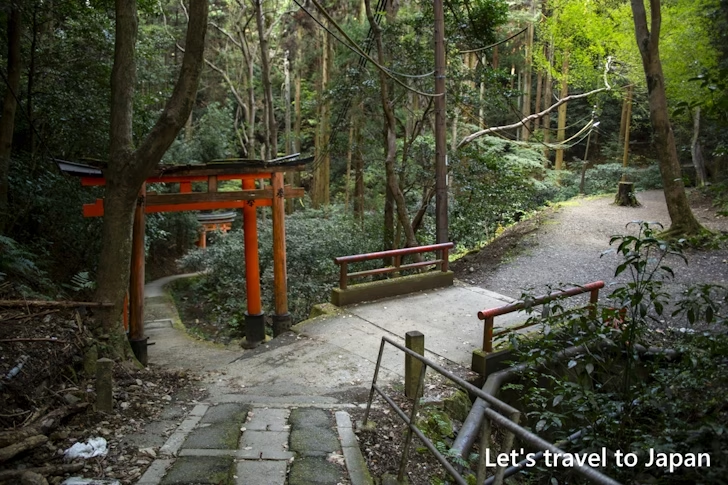
After proceeding further, you will come to Kiyotakisha. Kiyotaki is located within. When I visited, there seemed to be little water flowing, so it didn’t quite feel like a waterfall.
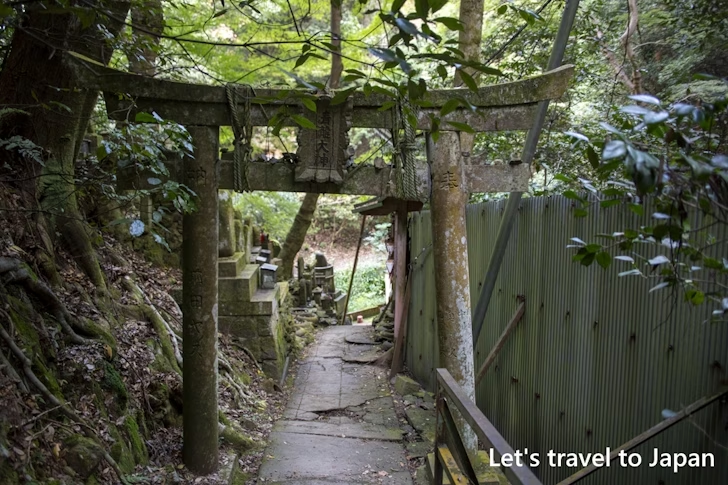
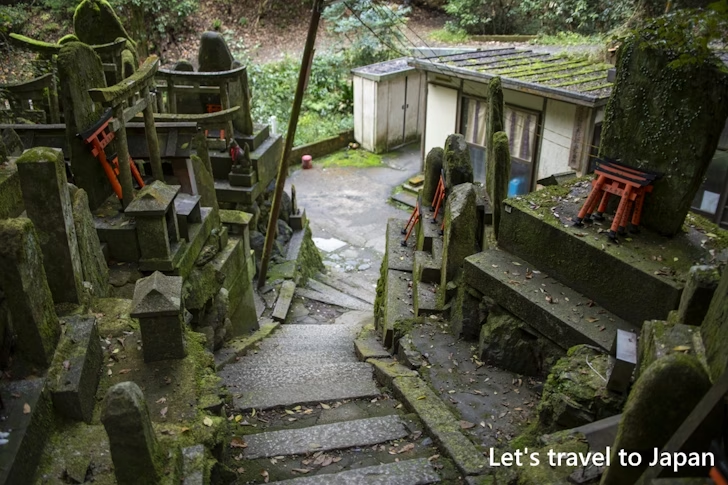
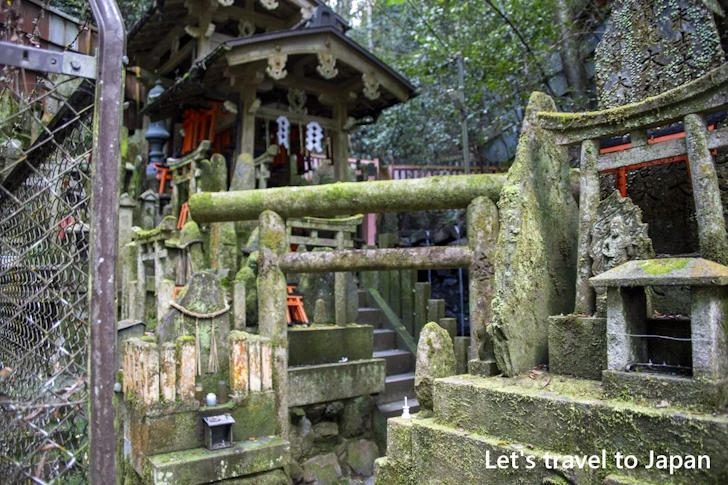
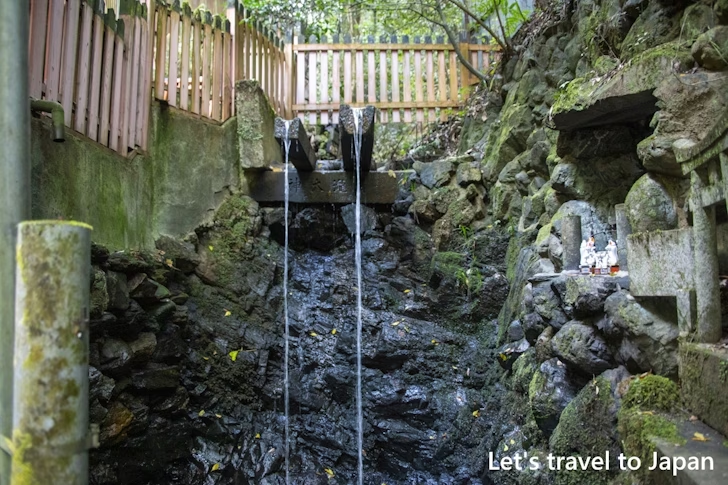
Returning to the original spot, this time I proceeded right towards the summit. The path just before the summit is the steepest so far, making it quite challenging. There is also a tea house along the way, so climb slowly without overexerting yourself.
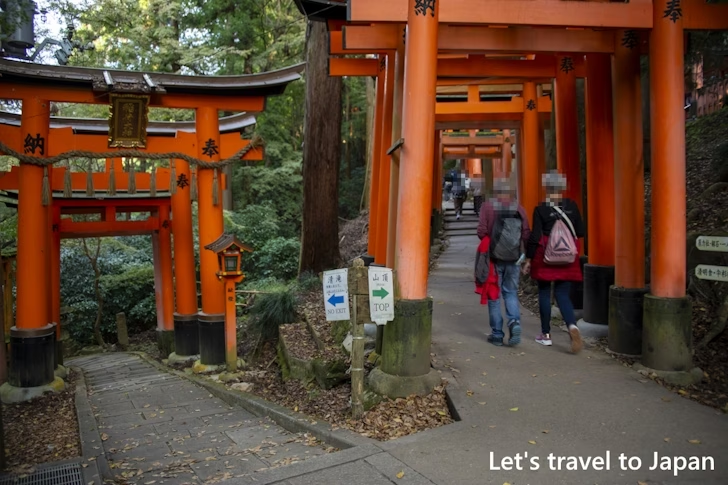
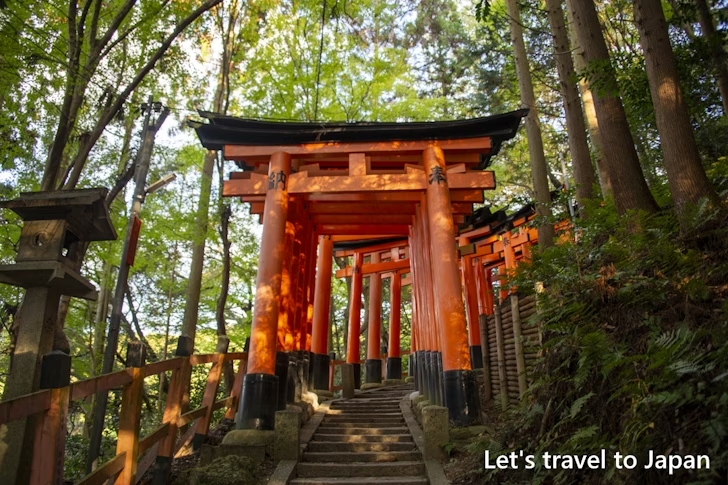
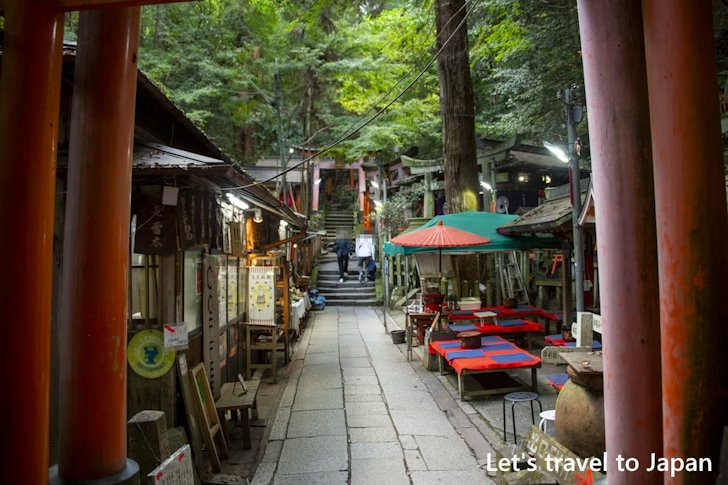
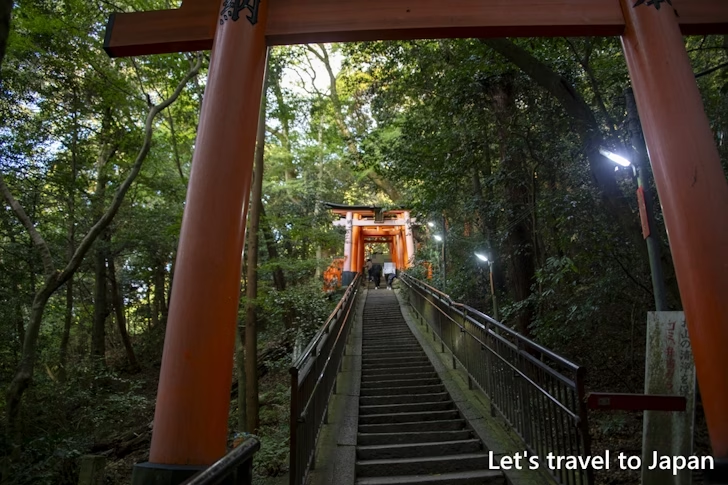
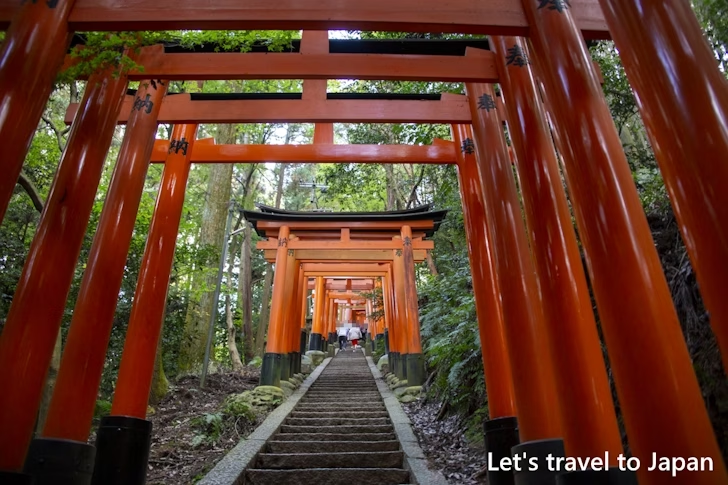
I have arrived at Ichinomine, the summit. At Ichinomine, there is the Kamino Yashiro Shinseki.
The Shinseki site is the original location of a shrine that was once in the mountains of Mount Inari. After being destroyed during the Onin-no-ran, it was never rebuilt, but in the Meiji era, seven such sites were identified and Oyazuka were constructed at each location. These are known as the Seven Shinseki.
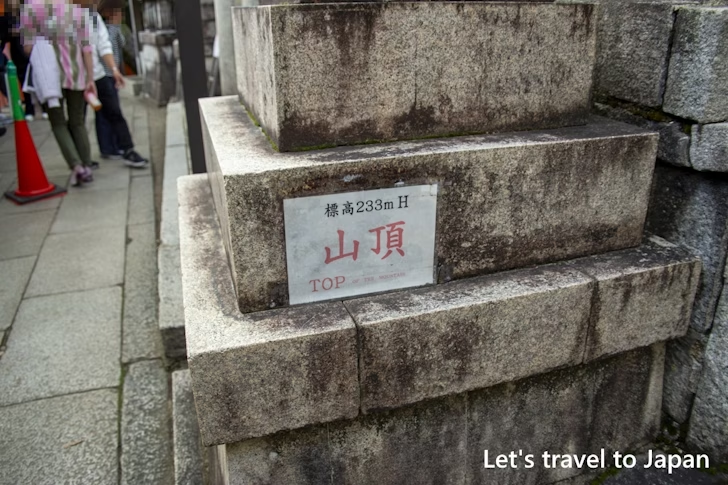
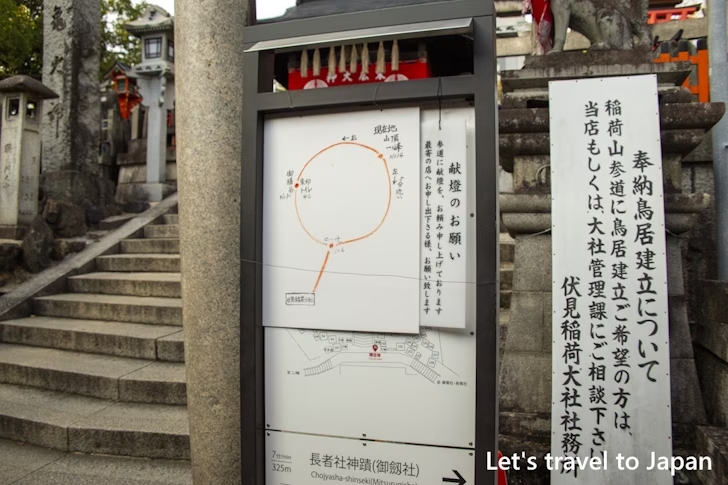
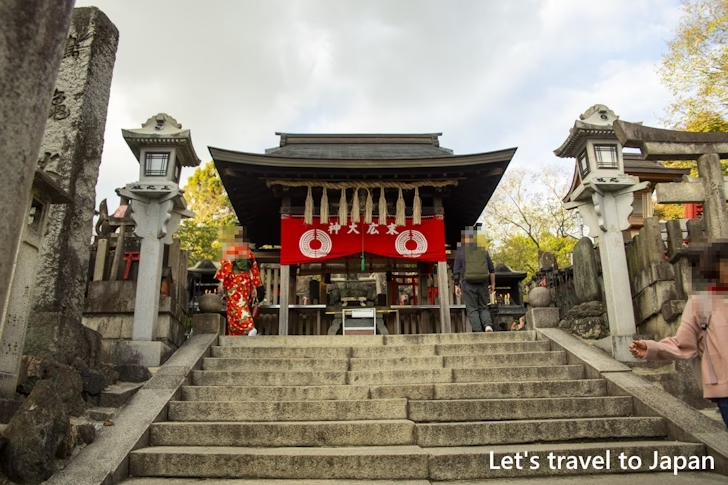
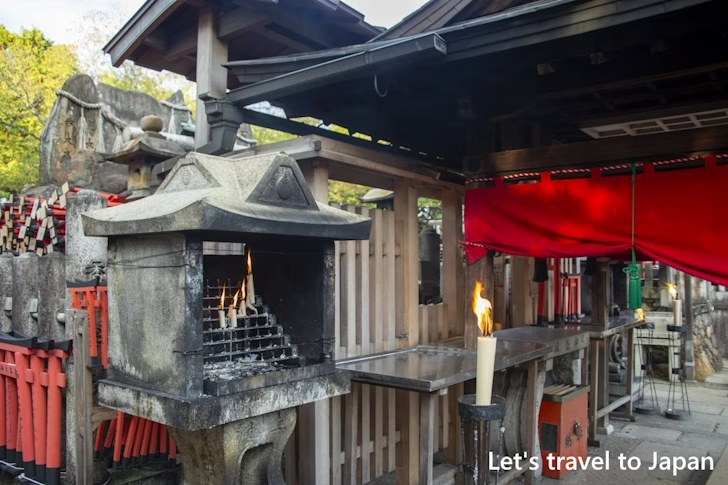
From the summit, I took the opposite route back to Yotsutsuji and then returned to the Honden. Between the summit and Yotsutsuji are Ninomine, Ainomine, and Sanomine. At Ninomine, there is the Nakano Yashiro Shinseki, at Ainomine is the Kada no Yashiro Shinseki, and at Sanomine is the Shimono Yashiro Shinseki.
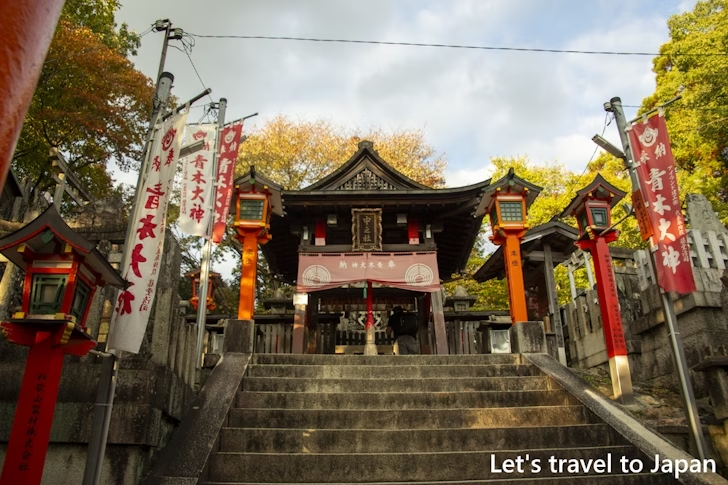
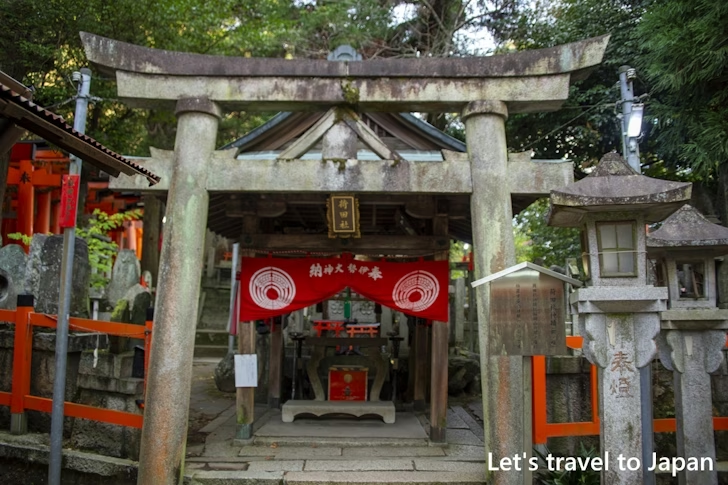
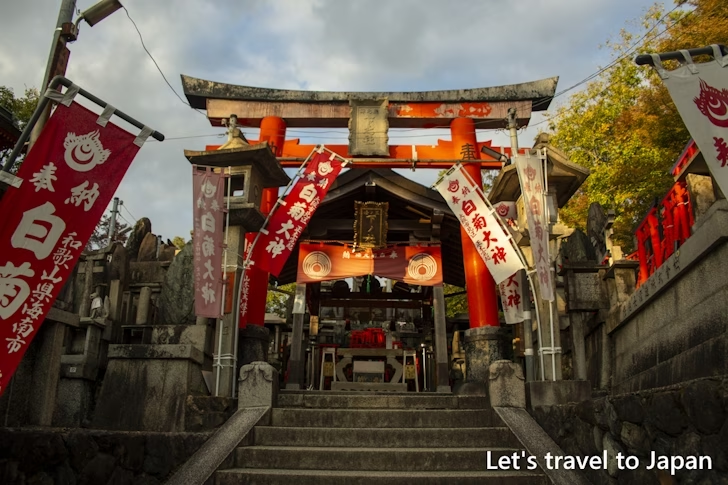
Stone Fox Statues at Fushimi Inari Taisha
At Fushimi Inari Taisha, there are many stone fox statues. These foxes are messengers of Inari Okami. These are not actual foxes found in the wild but invisible, transparent white foxes (byakko). Additionally, each fox is holding something in its mouth (though some are not holding anything). The items held by these foxes are "rice stalks," "keys to rice granaries," "jeweled orbs," and "scrolls," each of which has a connection to Inari Okami.
For more detailed information about Stone Fox Statues at Fushimi Inari Taisha, please see 「Complete Guide to the Stone Fox Statues at Fushimi Inari Taisha」.
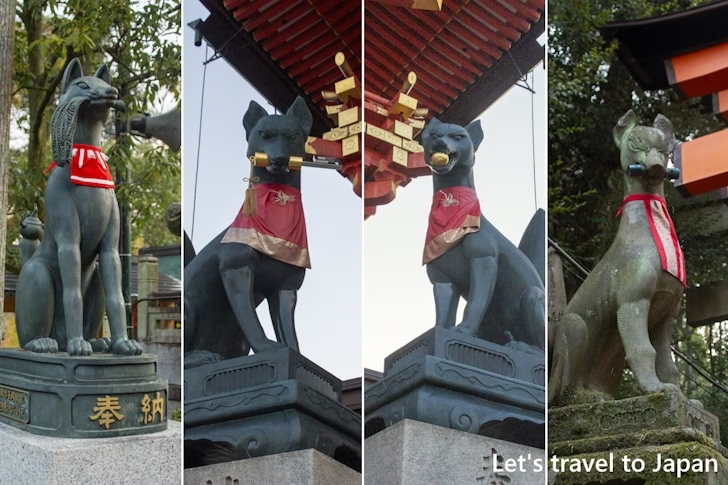
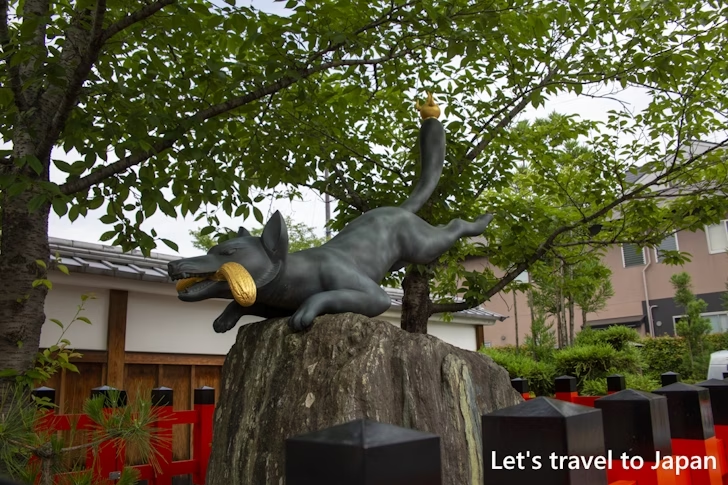
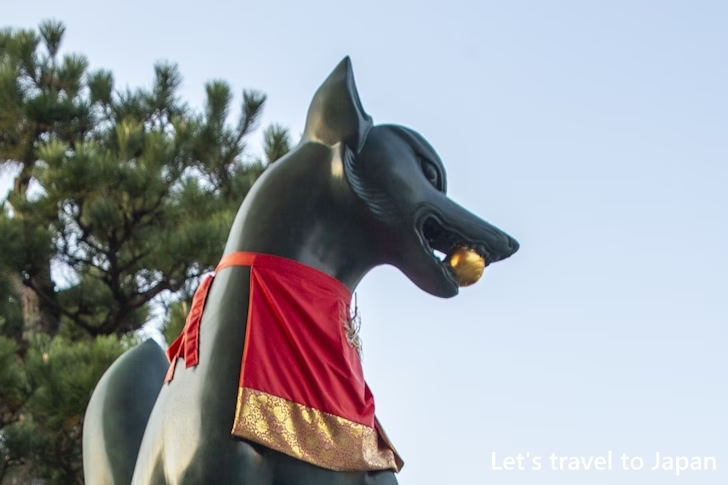
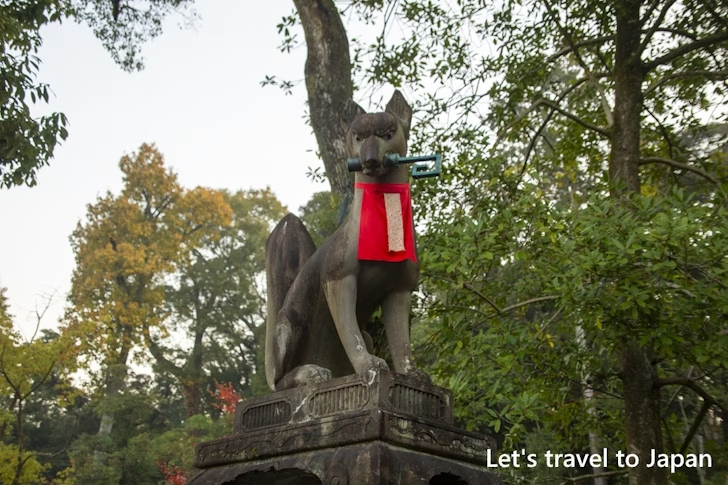
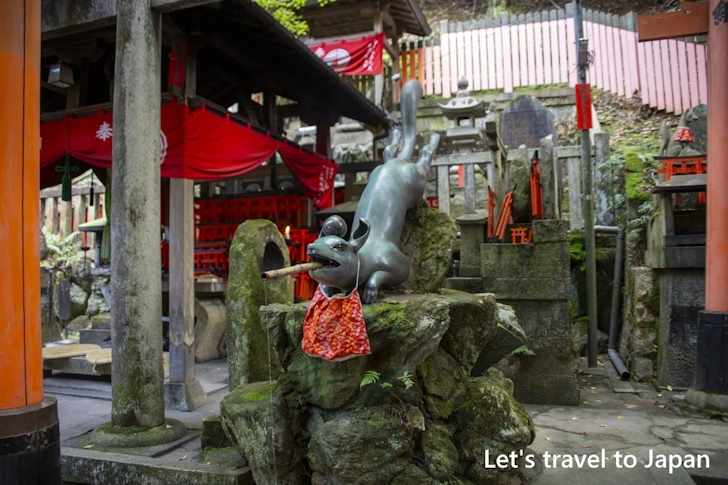
Autumn leaves at Fushimi Inari Taishas
The autumn leaves at Fushimi Inari Taisha typically reach their peak from mid-November to early December. Although Fushimi Inari Taisha is not specifically known as a destination for autumn leaves, the area around Teichouan is beautifully adorned with fall foliage.
For more detailed information about Autumn leaves at Fushimi Inari Taishas, please see 「Complete guide to the highlights of autumn leaves at Fushimi Inari Taisha」.
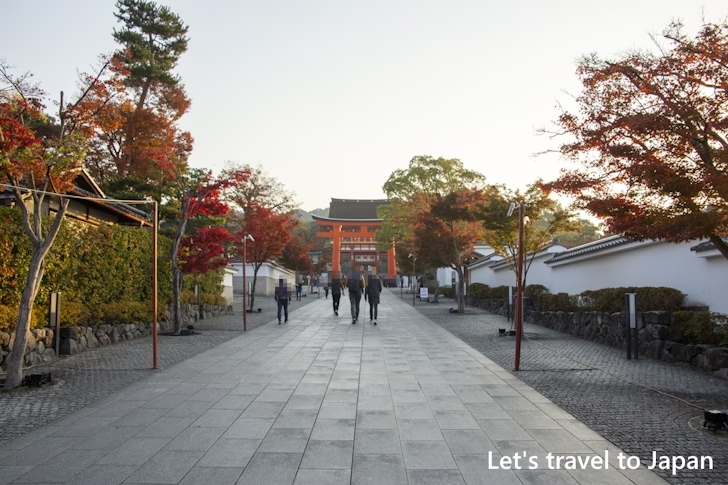
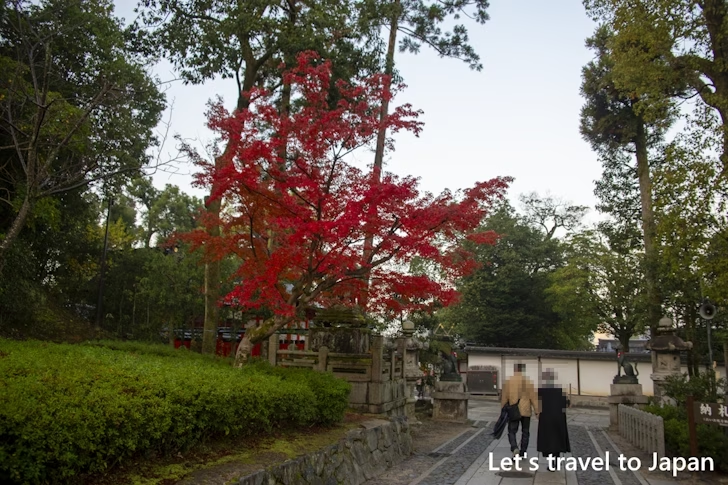
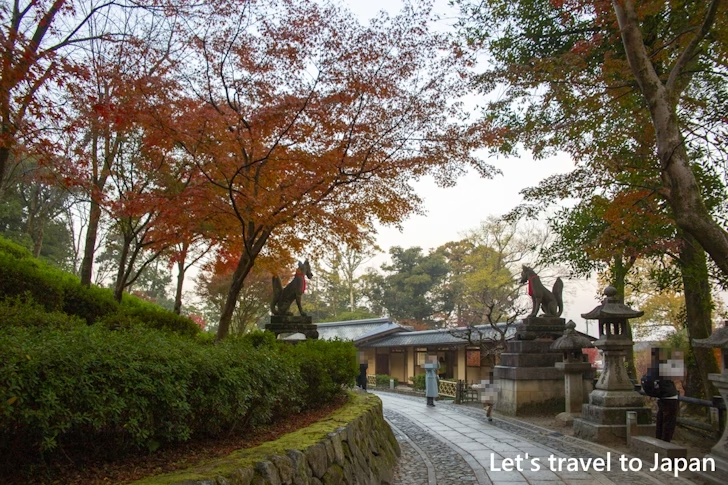
List of photos related to Fushimi Inari Taisha
Please see below for a list of photos related to Fushimi Inari Taisha.
Address and access method of Fushimi Inari Taisha
Address of Fushimi Inari Taisha
The address of Fushimi Inari Taisha is "68, Fukakusa Yabunouchi-cho, Fushimi-ku, Kyoto City, Kyoto Prefecture".
Access method of Fushimi Inari Taisha
I will explain how to access Fushimi Inari Taisha from Kyoto Station. The nearest stations are JR Inari Station or Keihan Railway Fushimi Inari Station.
When using JR Inari Station:
JR Nara Line
6 minutes
Short walk
When using Keihan Railway Fushimi Inari Station:
JR Nara Line
3 minutes
Keihan Railway Keihan Main Line
3 minutes
Walk
5 minutes
Fushimi Inari Taisha parking lot
Fushimi Inari Taisha Shrine has a large free parking lot. For information on how to use the parking lot, please see 「Complete guide to parking at Fushimi Inari Taisha」.
Attractions near Fushimi Inari Taisha
Several notable attractions are located near Fushimi Inari Taisha.
Tofukuji Temple
Just one stop away from Fushimi Inari on the JR Nara Line, Tofukuji is especially famous for its spectacular autumn colors and the view of the Tsutenkyo Bridge surrounded by maple trees.
Sake Breweries
Fushimi area is also known for sake brewing due to the quality of its water. Visitors can learn about the brewing process and taste different types of sake at the Gekkeikan Okura Sake Museum and several other breweries in the area.
Fushimi Port
A riverside park where you can rent a boat or take a river cruise. It offers lovely views, especially during cherry blossom season.
Fushimi Castle
Although a modern reconstruction, this castle has a small museum and offers good views over Kyoto from its observation deck. It's a short walk from Fushimi-Momoyama station.
Other information about Fushimi Inari Taisha
Official site about Fushimi Inari Taisha :
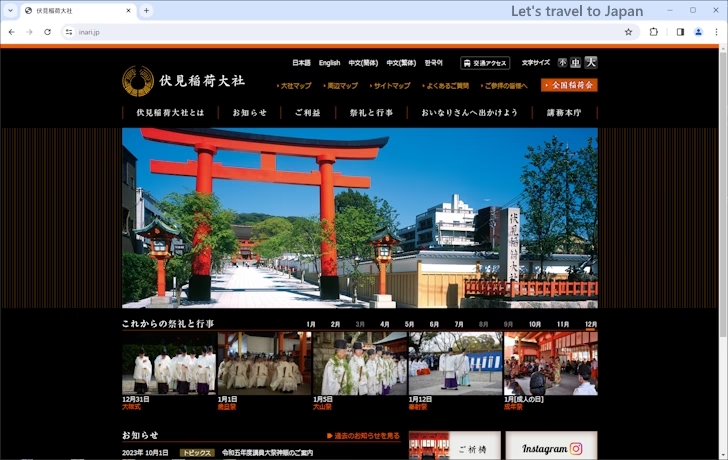
-- --
Thank you for reading to the end.
( Written by Tatsuo Ikura )